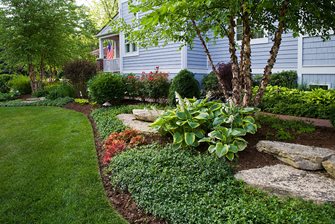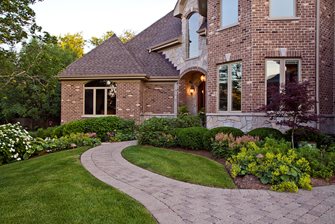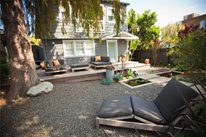How to Maintain Landscape Beds
Recommendations from an award-winning landscape management firm
-
 When it comes to maintenance, a landscape with large beds requires more attention to detail.
When it comes to maintenance, a landscape with large beds requires more attention to detail.
-
 Perennials and evergreens have different maintenance needs that should be addressed at different times during the year.
Perennials and evergreens have different maintenance needs that should be addressed at different times during the year.
-
 Fertilizer, aeration and grub control are all part of keeping a lawn properly maintained.
Fertilizer, aeration and grub control are all part of keeping a lawn properly maintained.
-
 Because it can be a challenge to grow grass in shady areas, mulch rings with shade perennials work best at the base of large trees.
Because it can be a challenge to grow grass in shady areas, mulch rings with shade perennials work best at the base of large trees.
- 1
- 2
- 3
- 4
Grant & Power's 5-Step Maintenance Plan:
Spring Cleanup
- Debris removal
- Cultivation of beds
- Spade edging of beds
- Application of slow release fertilizer
- Application of pre-emergent weed control
- Mulching or top-dressing
- Spring pruning
- Planting of annuals
Early Summer Maintenance
- Weeding
- Spade edging
- Pruning of spring flowering trees and shrubs
- Pruning of evergreens
Late Summer Maintenance
- Weeding and edging
- Dead heading perennials and annuals
- Pruning as needed
- Lawn needs evaluated
Fall Care & Winterizing
- Cleanup of beds
- Cutting back perennials
- Removal of dead annuals
- Removal of leaves and debris
Winterizing & Dormant Pruning
- Pruning of all summer flowering shrubs
- Dead wood removal
Keeping beds properly maintained can be an unforeseen challenge for homeowners with newly installed landscapes. Here, Grant & Power Landscaping shares how to properly maintain beds and other parts of the landscape.
What is the difference between a high-maintenance and low-maintenance landscape?A high-maintenance landscape may have many beds to enhance outdoor areas and home entrances. More perennials, shrubs, annuals, water features, and lighting means more maintenance.
Low-maintenance landscapes are mainly grass and just a few beds. A few tall shrubs or trees mean just mulch and occasional hand pruning, along with mowing the grass.
What maintenance is required to keep planting beds looking their best?Beds should be spade edged by hand in spring and refreshed every 8-10 weeks. Beds should be kept weeded on a monthly basis. In spring, we put down mulch and pre-emergent. Groundcover should be kept trimmed down, and prevented from invading surrounding plants. Shrubs need to be hand pruned to maintain a natural look and also trimmed back from the house. Dead branches from any trees would need to be cleaned up regularly. Additionally, roses need to be pruned until fall to keep blossoms in full show.
How do you ensure that both perennials and evergreens growing alongside each other receive the proper care?We suggest at least a 5-step program, which is every 8-10 weeks. A one-time cleanup can’t address this dilemma. Perennials and shrubs are pruned just after blooming in early spring or in late fall after new growth has hardened off. Evergreens are not cut back substantially, just shaped as needed for a natural look. We prefer not to use any gas or electric trimmers.
Why do you recommend mulch? Does mulch attract ants or promote mold?Mulch is extremely important to place around plant material for a number of reasons. In the winter months, mulch acts as a big warm blanket that helps insulate and protect plant roots. In the summer months it deflects the sunlight and keeps moisture in the ground, which helps keep the soil cooler. It also helps control the weed population.
Organic mulches will decompose over time, adding nutrients back into the soil. But because it decomposes, it will need to be replaced periodically. You can add a ½-1” topcoat of mulch every spring to aesthetically freshen up your garden, or add 2-3” every couple of years to restore what has been lost. Just because it decomposes doesn’t mean it’s not money well spent. You are helping amend the soil every time the mulch is applied. It’s an investment in the health of your plants and garden.
Mulch itself does not attract insects, but it may create an inviting environment. When the circumstances are right, insects will thrive in mulch. Over applying mulch, 4-6” deep, will create an environment that retains too much water and increased insect activity is likely. However, if the recommended 2-3” is applied, it will not provide enough moisture retention to increase insect activity.
Bacteria and fungi that live in all soil recognize mulch as a food source. If the mulch is continuously moist and temperatures are just right then the fungus will reproduce to the point that we will see it on the surface of the mulch. This is harmless to our live plants. The bacteria and fungi are strictly feeding on the wood mulch. Changing the environment will lessen the fungal growth. Keep the mulch dry. When watering, direct water to plant roots instead of the entire mulch bed. In rainy times, stir up the mulch with a rake or hoe to fluff up and dry out the mulch making it less hospitable for fungal growth.
What lawn care routine do you recommend? If the grass is full, we recommend 5 applications of fertilizer and weed control per year. Core aeration should be done once every 2-3 years. Additionally, we suggest grub control once a year as a preventative.
What maintenance impact do mature trees have on a landscape? Trees act as a windbreak, and also screening which many homeowners value. Additionally, if they surround a patio area or gazebo, it helps to suggest separation of "outdoor rooms". There may be a problem keeping grass looking good if there is a lot of shade. We would suggest mulch rings around the base, and if no grass can grow, mulch the bed and add some shade perennials.
Grant & Power Landscaping
Chicago, IL



 Lawn Care
Lawn Care Planting Mistakes
Planting Mistakes Low-Maintenance Landscaping
Low-Maintenance Landscaping

